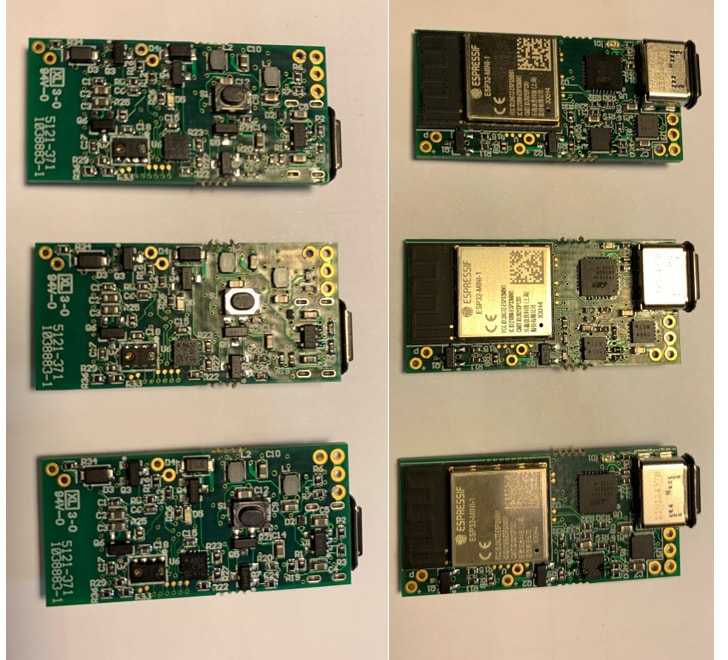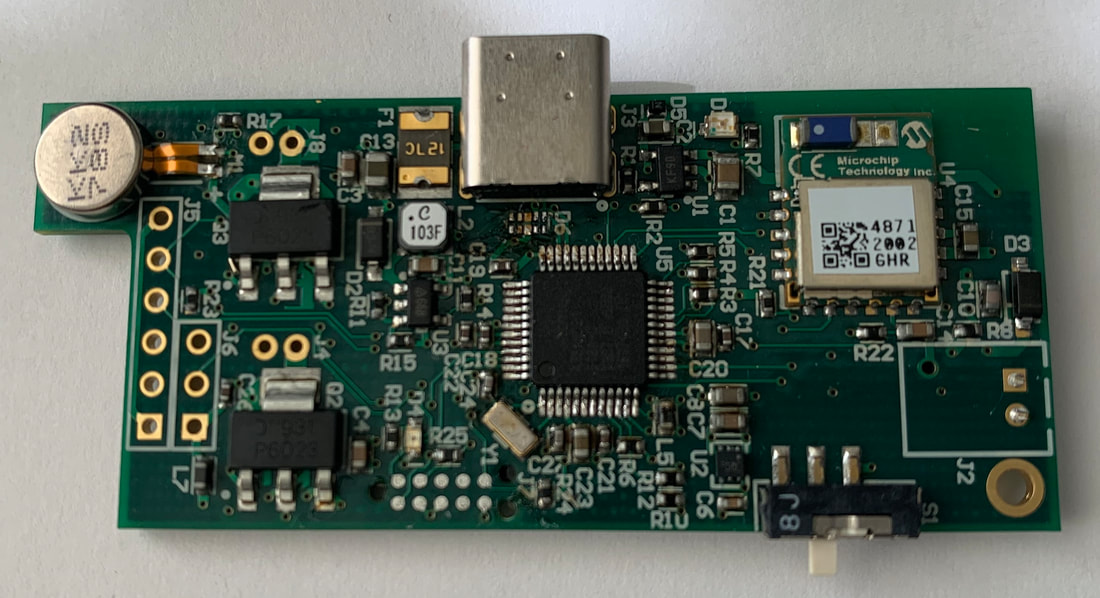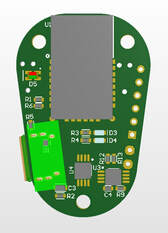Portfolio
Animal Wearable
|
Project Goal
Design a very low power animal wearable that controls dosing of medication over several months at a time. Must connect to WIFI and get device settings updates, share data, and adjust time accordingly. Includes both board design and firmware. Electronics
Challenges Optimizing system power usage and designing for battery life for as long as 120 days on a single charge. |
Audio Sequencer
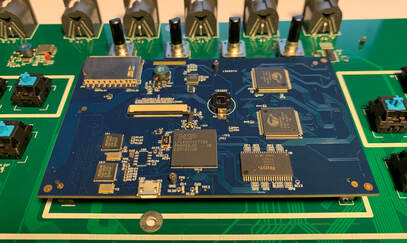
Project Goal
Design a system that provides interfaces to several audio ports and provides a main display, buttons, knobs, and smaller screens for user control. Consists of a main MCU board mounted to a backplane board, project included firmware development.
Electronics
Challenges
Optimizing system bandwidth to drive displays, manage quadrature decoders, and parse USB.
Design a system that provides interfaces to several audio ports and provides a main display, buttons, knobs, and smaller screens for user control. Consists of a main MCU board mounted to a backplane board, project included firmware development.
Electronics
- ARM Cortex Dual Core M4/M0+ 204MHz
- 38 Rotary Encoders
- 16 OLED displays
- 20 tactile switches
- UART/SPI/I2C
- External SDRAM
- USB 2.0 Highspeed
Challenges
Optimizing system bandwidth to drive displays, manage quadrature decoders, and parse USB.
High Power LED Controller
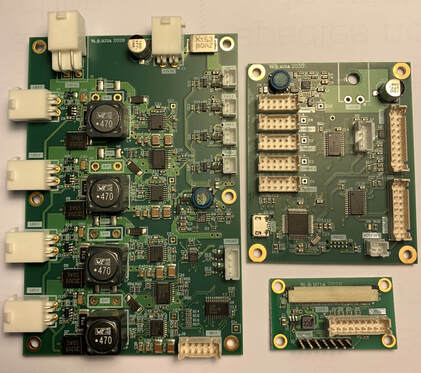
Project Goal
Design a system that delivers high power to several LED banks. Each bank requires individual control of brightness, while a touchscreen display and keypad allows for user operation. Project included firmware development.
Electronics
Challenges
Considerations for high power delivery at +48VDC.
Design a system that delivers high power to several LED banks. Each bank requires individual control of brightness, while a touchscreen display and keypad allows for user operation. Project included firmware development.
Electronics
- ARM Cortex M0+ 48MHz
- High Power LED Drivers
- SMBus Supply Interface
- Fans/Thermal Management
- E-Fuse System
- Current Sensing
- USB
Challenges
Considerations for high power delivery at +48VDC.
Heated Medical Device
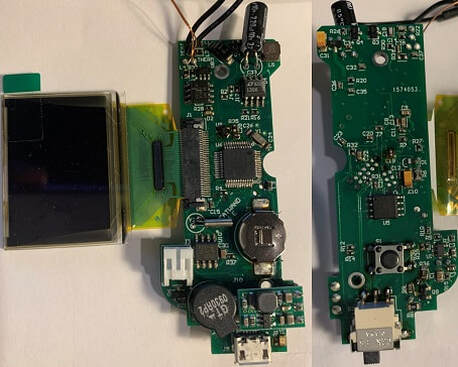
Project Goal
Design a proprietary battery-powered medical device that treats patients through a heated element. Electronics consist of an OLED screen, thermistor, heater, battery management, RTC component, main processor and small, secondary processor. Includes firmware development for both processors and manufacturing hand-off documentation/support.
Electronics
Challenges
Firmware algorithms for heater control (PID), supporting many different modes of operation, and complying with safety standards/requirements.
Design a proprietary battery-powered medical device that treats patients through a heated element. Electronics consist of an OLED screen, thermistor, heater, battery management, RTC component, main processor and small, secondary processor. Includes firmware development for both processors and manufacturing hand-off documentation/support.
Electronics
- ARM Cortex M0+ 48MHz
- ATTiny 8-bit Microcontroller
- Full Color OLED screen
- Heater Element
- Thermistor
- Buzzer
- RTC
- Battery Management
- USB
Challenges
Firmware algorithms for heater control (PID), supporting many different modes of operation, and complying with safety standards/requirements.
Proprietary Medical Device
|
Project Goal
Design a proprietary battery-powered medical device consisting of a heater, LCD screen, Fingerprint Sensor, Airflow detector, vibrating motor, and Bluetooth Module. Project included firmware development. Electronics
Challenges Building a state machine for robust operation for a fairly complicated workflow and delivering up to 10W of heat in a space constrained application. |
Proprietary Body Sensing System
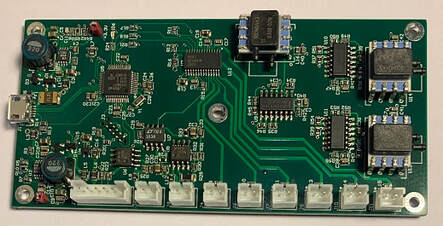
Project Goal
Design a system for various types of measurements and wearable sensors, including blood pressure, muscle monitor via piezo actuation, electro-dermal activity, body temperature, heartrate and spO2.
Electronics
Challenges
Providing a high speed USB logging feature for a Software GUI interface and optimizing sampling speed of peripherals.
Design a system for various types of measurements and wearable sensors, including blood pressure, muscle monitor via piezo actuation, electro-dermal activity, body temperature, heartrate and spO2.
Electronics
- ARM Cortex M0+ 48MHz
- 32-bit 10 Channel ADC
- Serial Connection for Pulse Oximetry
- Current Source for Thermistor and EDA circuitry
- Analog connections for piezos and pressure sensors
Challenges
Providing a high speed USB logging feature for a Software GUI interface and optimizing sampling speed of peripherals.
Technical Articles for Aspencore, featured on Arrow Electronics, EE Times, TI.com
Texas Instruments
Designing a Compact Small Signal Chain
White paper for designing small signal chain electronics for high performance in a small footprint
https://www.ti.com/lit/wp/snaa341/snaa341.pdf
Arrow Electronics
Electronics inside the Human Microbiome
Technical Article on the history and recent advances of implantable and wearable electronics interfacing with the human microbiome
https://www.arrow.com/en/research-and-events/articles/recent-advances-in-implantable-and-biomems-electronics
Arrow Electronics
Bluetooth Technologies and Solutions
Technical Article on Bluetooth technology with focus on major recent start-up companies and their disruptive technologies
https://www.arrow.com/en/research-and-events/articles/bluetooth-technologies-and-solutions
Arrow Electronics
Taking a Quantum Leap in Cryptography and Computing
Technical Article on Quantum Cryptography/Computing and it's uses in the industry
https://www.arrow.com/en/research-and-events/articles/taking-a-quantum-leap-in-security-and-computing
Arrow Electronics
Artificial Intelligence in the Industry
Technical Article on Artificial Intelligence and it's uses in the industry
https://www.arrow.com/en/research-and-events/articles/artificial-intelligence-in-the-industry
Arrow Electronics/Meanwell
Improve the Performance of Industrial and Medical Applications with Modular Power Supplies
Technical article on modular power supplies with focus on Meanwell NMP product series, features, and performance
https://www.arrow.com/en/research-and-events/articles/improve-the-performance-of-industrial-and-medical-applications-with-modular-power-supplies
Silicon Labs
Re-imagining Today's Isolation Solutions for Tomorrow's Technologies
Technical article on RF-based isolation technology with focus on Silicon lab products and performance
https://www.eetimes.com/reimagining-todays-isolation-solutions-for-tomorrows-technologies/#
Designing a Compact Small Signal Chain
White paper for designing small signal chain electronics for high performance in a small footprint
https://www.ti.com/lit/wp/snaa341/snaa341.pdf
Arrow Electronics
Electronics inside the Human Microbiome
Technical Article on the history and recent advances of implantable and wearable electronics interfacing with the human microbiome
https://www.arrow.com/en/research-and-events/articles/recent-advances-in-implantable-and-biomems-electronics
Arrow Electronics
Bluetooth Technologies and Solutions
Technical Article on Bluetooth technology with focus on major recent start-up companies and their disruptive technologies
https://www.arrow.com/en/research-and-events/articles/bluetooth-technologies-and-solutions
Arrow Electronics
Taking a Quantum Leap in Cryptography and Computing
Technical Article on Quantum Cryptography/Computing and it's uses in the industry
https://www.arrow.com/en/research-and-events/articles/taking-a-quantum-leap-in-security-and-computing
Arrow Electronics
Artificial Intelligence in the Industry
Technical Article on Artificial Intelligence and it's uses in the industry
https://www.arrow.com/en/research-and-events/articles/artificial-intelligence-in-the-industry
Arrow Electronics/Meanwell
Improve the Performance of Industrial and Medical Applications with Modular Power Supplies
Technical article on modular power supplies with focus on Meanwell NMP product series, features, and performance
https://www.arrow.com/en/research-and-events/articles/improve-the-performance-of-industrial-and-medical-applications-with-modular-power-supplies
Silicon Labs
Re-imagining Today's Isolation Solutions for Tomorrow's Technologies
Technical article on RF-based isolation technology with focus on Silicon lab products and performance
https://www.eetimes.com/reimagining-todays-isolation-solutions-for-tomorrows-technologies/#
Multi-Use USB Dongle
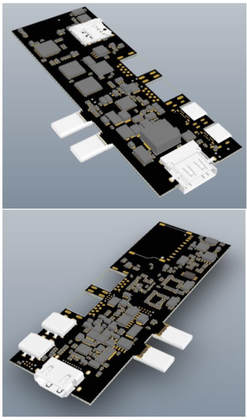
Project Goal
Do PCB layout and schematic design for a high speed device used as a USB dongle, allowing connectivity for various uses. Consists of USB 3.0 hubs, display port to HDMI, micro and normal SD card readers, USB C power controller and charger management for power delivery, various power management, and a confidential feature including high speed communication and memory storage.
Layout/Design Requirements
Challenges
Accounting for high speed traces and managing 100W of power delivery via USB C
Do PCB layout and schematic design for a high speed device used as a USB dongle, allowing connectivity for various uses. Consists of USB 3.0 hubs, display port to HDMI, micro and normal SD card readers, USB C power controller and charger management for power delivery, various power management, and a confidential feature including high speed communication and memory storage.
Layout/Design Requirements
- USB C
- 100W power delivery
- HDMI
- SD card signals
- Confidential data and memory storage
- Low-profile, custom shaped
Challenges
Accounting for high speed traces and managing 100W of power delivery via USB C
Smart Home Device
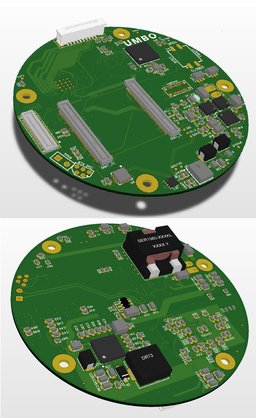
Project Goal
Do PCB layout and schematic design for a device used in a smart home application. Consists of a mount for a Qualcomm based processor and several high speed signals to various interfaces and sensors, and connections to off-board peripherals.
Layout/Design Requirements
Challenges
Accounting for high speed traces and developing a power section isolated from the sensitive digital domain.
Do PCB layout and schematic design for a device used in a smart home application. Consists of a mount for a Qualcomm based processor and several high speed signals to various interfaces and sensors, and connections to off-board peripherals.
Layout/Design Requirements
- Some high speed areas
- Several lower speed serial connections (I2C, SPI, UART)
- Several low voltage power supplies
- High power LED traces
- Various other on-board sensors
- Low-profile, height restrictive areas while minimizing layer count
Challenges
Accounting for high speed traces and developing a power section isolated from the sensitive digital domain.
Drum Triggering Device
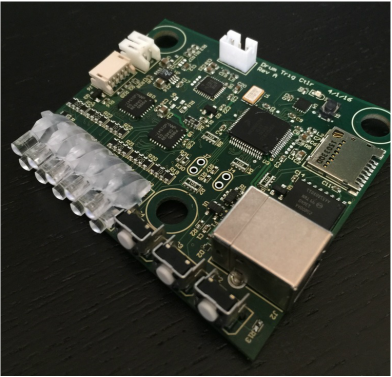
Project Goal
Design a circuit that allows for a proprietary triggering method on a drum. The device plays back stored sound files via an audio jack that can be pre-programmed for several scenes using a GUI (connected via USB) and stored on a local SD card.
Electronics
Software
Challenges
Optimizing sensor trigger logic and audio file read/play speed, configuring for sound mixing, isolating vibration, and keeping noise/coupling to a minimum.
Design a circuit that allows for a proprietary triggering method on a drum. The device plays back stored sound files via an audio jack that can be pre-programmed for several scenes using a GUI (connected via USB) and stored on a local SD card.
Electronics
- ARM Cortex M4 94MHz
- Audio Codec
- 15-Channel LED Driver
- microSD card
- Proximity and Force Sensors
- Misc Power Management
Software
- USB Command/data interface for GUI connection
- SPI SD card interface
- I2S/I2C audio codec interface
- I2C proximity sensor interface
- I2C LED driver interface
- Freescale Microcontroller programmed in C
Challenges
Optimizing sensor trigger logic and audio file read/play speed, configuring for sound mixing, isolating vibration, and keeping noise/coupling to a minimum.
High Resolution Measurement System
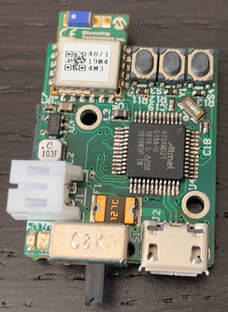
Project Goal
Design a wireless, battery-powered system that interfaces with a high resolution encoder for taking measurements on mechanical parts.
Electronics
Challenges
Building quadrature encoder function to sample fast enough and keep reliable count of position
Design a wireless, battery-powered system that interfaces with a high resolution encoder for taking measurements on mechanical parts.
Electronics
- Interface to 1um 1MHz encoder
- Bluetooth Module
- ARM M0+ Processor
- USB interface
- Zero, units, and on/off functions with optimized sleep algorithms
Challenges
Building quadrature encoder function to sample fast enough and keep reliable count of position
Bluetooth/RTC Extension of a Medical Device
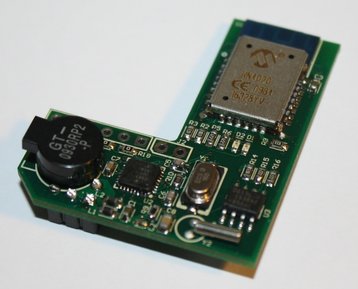
Project Goal
Design a board that mounts to a main processing boards and acts as a Bluetooth extension of the device, transmitting treatment data to an App. The device interprets UART commands from the main processor (PIC18F) via a small microcontroller (AVR ATMega) and coordinates data to/from the BLE module. Other on-board peripherals consist of a buzzer and a Real Time Clock (RTC) module for treatment time data. Project also consisted of programming the PIC with the required command set, and sending data to the App during the appropriate time.
Electronics
Software
Challenges
Developing the interface between the PIC and the AVR microcontrollers and their associated command sets. Mechanical considerations and 3D modeling for a tight fit inside a pre-existing enclosure.
Design a board that mounts to a main processing boards and acts as a Bluetooth extension of the device, transmitting treatment data to an App. The device interprets UART commands from the main processor (PIC18F) via a small microcontroller (AVR ATMega) and coordinates data to/from the BLE module. Other on-board peripherals consist of a buzzer and a Real Time Clock (RTC) module for treatment time data. Project also consisted of programming the PIC with the required command set, and sending data to the App during the appropriate time.
Electronics
- Embedded AVR microcontroller
- RTC module with coin cell battery
- Bluetooth Module
- Buzzer and other misc circuitry
Software
- PWM signal for buzzer
- UART interface between the PIC and AVR microcontrollers
- UART interface between the AVR microcontroller and Bluetooth Module
- I2C interface between the RTC device and AVR microcontroller
Challenges
Developing the interface between the PIC and the AVR microcontrollers and their associated command sets. Mechanical considerations and 3D modeling for a tight fit inside a pre-existing enclosure.
Bluetooth Pet Training Device
|
Project Goal
Design a 2-piece wirelessly controlled, battery-operated, pet training system that contains a high frequency transducer (for corrective behavior) and a Bluetooth Module on each component running a proprietary algorithm that estimates the distance between them. Electronics
Challenges Developing very specific parameters for sleeping and waking upon external events to conserve battery life. Building in sophisticated routines of driving the transducer to maximize training impact. |
High Power Work Light

Project Goal
Design a small board that can power an LED with up to 7.5W of power with a variety of dimming and brightness setting features. Board is powered via USB and in one variation uses capacitive touch (via the light's metallic base housing) to control brightness/dimming levels, while using a standard momentary pushbutton in another variation.
Electronics
Software
Challenges
Developing high power circuitry at a low voltage and in a very compact form.
Design a small board that can power an LED with up to 7.5W of power with a variety of dimming and brightness setting features. Board is powered via USB and in one variation uses capacitive touch (via the light's metallic base housing) to control brightness/dimming levels, while using a standard momentary pushbutton in another variation.
Electronics
- Embedded AVR microcontroller (ATTiny25)
- 12V step-up converter and LED driving circuitry
- Capacitive touch sensor
Software
- ADC for power monitoring
- GPIO for capacitive touch input and LED control
- State machine logic for controlling dimming/brightness levels
Challenges
Developing high power circuitry at a low voltage and in a very compact form.
10,000mAh Portable Power Bank
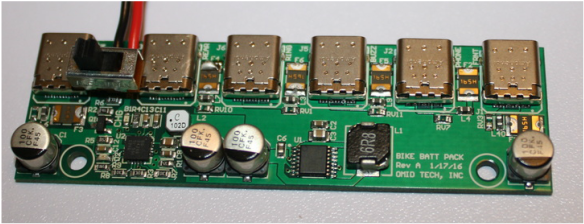
Project Goal
Design a power bank with 5 x USB Type C power ports to charge and power a variety of accessories. Includes a 10,000mAh battery and fast charging circuitry, all components completely analog.
Electronics
Challenges
Optimizing battery charge circuitry and powering devices at full load capacity.
Design a power bank with 5 x USB Type C power ports to charge and power a variety of accessories. Includes a 10,000mAh battery and fast charging circuitry, all components completely analog.
Electronics
- USB Type C Power
- High capacity battery charger with temperature monitoring
- 5V Step-up Converter
- Proprietary accessories with high power LEDs and analog-based timers.
Challenges
Optimizing battery charge circuitry and powering devices at full load capacity.
PCB Design for High Speed Daughter Card
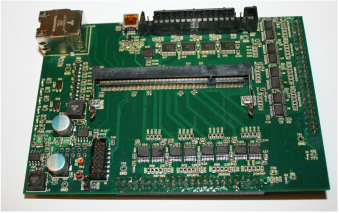
Project Goal
Design PCB for proprietary application (using pre-existing design), including Gigabit Ethernet and high speed, differential, isolated signals meant to interface with a processing core and a back-plane board. Included some schematic editing, creating parts in libraries and completing PCB layout and GERBER prep.
Components and Considerations
Challenges
PCB Layout with differential pairs, isolated planes, and other high speed design considerations/practices. Mechanical considerations including precise bottom-side connector location for board mounting.
Design PCB for proprietary application (using pre-existing design), including Gigabit Ethernet and high speed, differential, isolated signals meant to interface with a processing core and a back-plane board. Included some schematic editing, creating parts in libraries and completing PCB layout and GERBER prep.
Components and Considerations
- Digital Isolation
- DC-DC Converters
- Ethernet MagJack
- USB/UART
- Other Misc
Challenges
PCB Layout with differential pairs, isolated planes, and other high speed design considerations/practices. Mechanical considerations including precise bottom-side connector location for board mounting.
Remote-Controlled, Inductively Powered LED
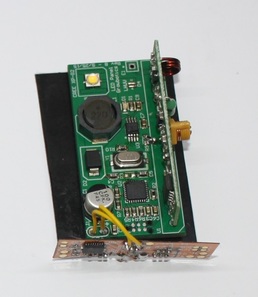
Project Goal
Design a remote-controlled, high-power LED system, powered wirelessly (via inductive power). Also designed a test unit (base transmitter) to send commands and control LED brightness, and an inductive power base transmitter.
Electronics
Software
Challenges
Limiting and filtering noise coupled from wireless receiver and inductive receiver units, and optimizing power management with regards to inductive power.
Design a remote-controlled, high-power LED system, powered wirelessly (via inductive power). Also designed a test unit (base transmitter) to send commands and control LED brightness, and an inductive power base transmitter.
Electronics
- Embedded AVR microcontroller
- RF Receiver (415MHz)
- Wireless Inductive Receiver, utilizing Qi
- High power CREE LED
Software
- Wireless serial interface (custom)
- Fast PWM signal for LED brightness control
- Atmel AVR microcontroller programmed in C using Arduino IDE
Challenges
Limiting and filtering noise coupled from wireless receiver and inductive receiver units, and optimizing power management with regards to inductive power.
Electronic Airsoft Rifle Controller
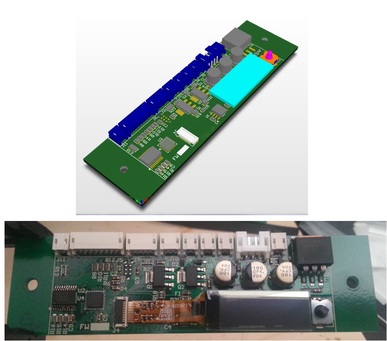
Project Goal
Design a compact, low profile controller that integrates with an airsoft rifle. Interfaces to an OLED display for trigger/firing settings and switches/buttons to navigate the menu. Achieved required shooting speed of 40 rounds per second.
Electronics
Software
Mechanical
Challenges
Making the solenoids activate independently with 100us resolution and as little as 2.5ms between actuations and allowing internal mechanical parts to settle.
Design a compact, low profile controller that integrates with an airsoft rifle. Interfaces to an OLED display for trigger/firing settings and switches/buttons to navigate the menu. Achieved required shooting speed of 40 rounds per second.
Electronics
- Embedded AVR microcontroller
- Two Solenoid driving channels
- 7.4V NiMH battery with monitoring circuitry
- OLED Display
- GPIO Port expander
- Misc switch and LED interfaces
- External feed motor connection
Software
- I2C interfaces with the OLED display and GPIO port expander
- Fast PWM signals for solenoid control
- On-board ADC port for monitoring battery level
- ATXMega Atmel microcontroller programmed in C using Atmel Studio
- Software provides several different triggering and firing modes
Mechanical
- Providing strong, reliable cable connections
- Provide specific mounting points for main and satellite PCBAs
Challenges
Making the solenoids activate independently with 100us resolution and as little as 2.5ms between actuations and allowing internal mechanical parts to settle.
Vibrating Alarm
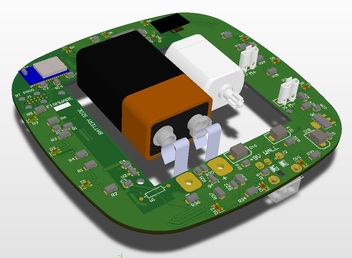
Project Goal
Assist in the hardware development of a vibrating puck, controlled remotely via Bluetooth and an app. My tasks included some schematic design, component selection, PCBA layout, assembly, and testing.
Electronics
Mechanical
Challenges
Working closely with the mechanical engineer to optimize mechanical features and component location/height.
Assist in the hardware development of a vibrating puck, controlled remotely via Bluetooth and an app. My tasks included some schematic design, component selection, PCBA layout, assembly, and testing.
Electronics
- Combo BLE/microcontroller device
- Drive electronics for motor containing counterweight
- Several LED channels
- Connection for 9V battery
Mechanical
- Incorporate mechanical keep-out zones, mounting features, and slots for motor and battery
Challenges
Working closely with the mechanical engineer to optimize mechanical features and component location/height.
Firearm Monitoring Device

Project Goal
Design a small, compact data logger embedded in a firearm that collects location and device orientation/motion.
Electronics
Software
Mechanical
Challenges
Optimizing GPS sensitivity for a solid, quick fix, and configuring the flash device to read and log data quickly enough between SPI transfers as to not slow down data flow.
Design a small, compact data logger embedded in a firearm that collects location and device orientation/motion.
Electronics
- Combo BLE/microcontroller device
- GPS Module
- 1GB Serial Flash
- 9-axis Motion Monitor
- Li-Po Battery and Charger
Software
- SPI interfaces with the GPS, Flash, and Motion Monitor
- RFDigital device programmed in C, using Arduino environment
Mechanical
- Enclosure and Mechanical Interface Design
- Design for precise wiring/cabling
Challenges
Optimizing GPS sensitivity for a solid, quick fix, and configuring the flash device to read and log data quickly enough between SPI transfers as to not slow down data flow.
Video Game Controller
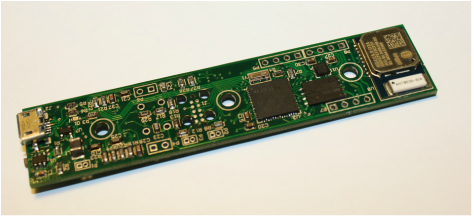
Project Goal
Design a vibrating, blinking, motion sensing, remote controlled PCBA for a video game application, with focus on hardware development.
Electronics
Challenges
Laying out the PCBA to be as compact as possible, but still allow for prototyping and accessibility with test points.
Design a vibrating, blinking, motion sensing, remote controlled PCBA for a video game application, with focus on hardware development.
Electronics
- 16-bit TI Microcontroller
- Bluetooth Module
- 256MB Serial Flash
- 9-axis Motion Monitor
- Li-Ion Battery, Charger, and Fuel Gauge
- 9-Channel LED Driver for 3 RGB LEDs
- 2-Channel I2C Serial MUX
- 2 x Haptic Motors and Driver ICs
Challenges
Laying out the PCBA to be as compact as possible, but still allow for prototyping and accessibility with test points.
Peltier Controller
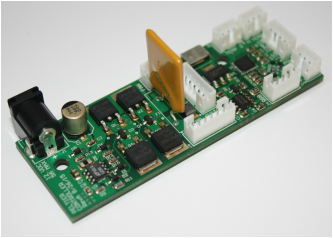
Project Goal
Design a device that can drive a Peltier Thermoelectric Cooler at up to 36W for a proprietary application. Includes dual direction (heat and cool) control, along with temperature feedback and visual indication of operational states.
Electronics
Software
Challenges
Programming in specific heating and cooling profiles and optimizing the PID control through testing iterations.
Design a device that can drive a Peltier Thermoelectric Cooler at up to 36W for a proprietary application. Includes dual direction (heat and cool) control, along with temperature feedback and visual indication of operational states.
Electronics
- Embedded AVR microcontroller
- H-Bridge with MOSFET drivers
- RGB LED and misc GPIO
- Fan port
Software
- PWM interface to H-bridge
- On-board ADC for temperature sensors
- ATXMega Atmel microcontroller programmed in C using Atmel Studio
Challenges
Programming in specific heating and cooling profiles and optimizing the PID control through testing iterations.
High Accuracy Thermometer
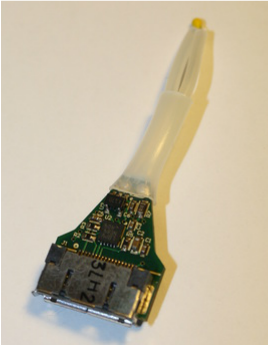
Project Goal
Design a small, compact dongle used for measuring body temperature, interfaced to and integrated with pre-existing electronics.
Electronics
Software
Challenges
Designing for 0.01 degree C resolution and 0.05 degree C accuracy.
Design a small, compact dongle used for measuring body temperature, interfaced to and integrated with pre-existing electronics.
Electronics
- 24-bit ADC and 2.5 voltage reference
- 200uA current source
- High precision thermistor
- Misc analog conditioning circuitry
Software
- I2C interface with ADC
- Lookup Table for Thermistor
Challenges
Designing for 0.01 degree C resolution and 0.05 degree C accuracy.
SFCircuits PCB School Articles
Technical article on electronic PCB interconnections
Part 1: http://www.sfcircuits.com/pcb-school/electronic-interconnect-design-considerations
Part 2: http://www.sfcircuits.com/pcb-school/electronic-interconnect-considerations-part-2
Technical article on Bluetooth technology
https://www.sfcircuits.com/pcb-school/pcb-design-for-bluetooth-circuit-boards
Technical article on PCB Design CAD Program Comparisons
https://www.sfcircuits.com/pcb-school/pcb-design-software-comparison-guide
Technical article on advantages of using pogo-pin based connectors on PCBs
https://www.sfcircuits.com/pcb-school/pogo-pin-based-interface-for-saving-space
Part 1: http://www.sfcircuits.com/pcb-school/electronic-interconnect-design-considerations
Part 2: http://www.sfcircuits.com/pcb-school/electronic-interconnect-considerations-part-2
Technical article on Bluetooth technology
https://www.sfcircuits.com/pcb-school/pcb-design-for-bluetooth-circuit-boards
Technical article on PCB Design CAD Program Comparisons
https://www.sfcircuits.com/pcb-school/pcb-design-software-comparison-guide
Technical article on advantages of using pogo-pin based connectors on PCBs
https://www.sfcircuits.com/pcb-school/pogo-pin-based-interface-for-saving-space
Wearable Medical Device for Therapeutic Application
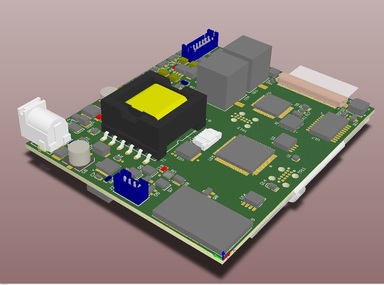
Project Goal
Design a compact, low profile wear-able device that is used for a proprietary therapeutic application with an accompanying app for iOS devices (unit is classified as a Class 3 medical device). The device includes a touchscreen display, bluetooth module, accelerometer, buzzer, re-chargeable battery and circuitry for charging support, and misc power control. App is used for patient monitoring, data collection, and remote control.
Electronics
Software
Mechanical
Challenges
Providing a robust network of interfaces between all components and meeting strict power control requirements, touchscreen user interface requirements, meeting medical device standards, establishing a secure/stable bluetooth connection, and designing an App with a modern look and feel.
Design a compact, low profile wear-able device that is used for a proprietary therapeutic application with an accompanying app for iOS devices (unit is classified as a Class 3 medical device). The device includes a touchscreen display, bluetooth module, accelerometer, buzzer, re-chargeable battery and circuitry for charging support, and misc power control. App is used for patient monitoring, data collection, and remote control.
Electronics
- High-end embedded microcontroller (Atmel)
- 3.5" TFT LCD Touchscreen and 4-wire touchscreen controller
- Bluetooth Module
- Charging circuitry and safety elements that meet IEC 60601-1 3rd Rev medical device standards
- Power control (H-bridge, boost controller, misc sensing)
- 3-axis Accelerometer, motion detection and "wake up" sensing
- Buzzer and LEDs for indication during operation
- External flash memory for images and configuration settings
Software
- SPI interfaces with the touchscreen, touchscreen controller, and external flash memory
- I2C interfaces with the accelerometer and charging circuitry
- UART connection with bluetooth module
- Fast PWM signals for power control
- On-board ADC ports for monitoring power control elements
- ATXMega Atmel microcontroller programmed in C using Atmel Studio
- Microcontroller provides patient-specific therapy profiles and saves/exports settings and data
- App design for iOS devices using Objective C
Mechanical
- Enclosure design
- Thermal analysis and meeting medical regulatory requirements
- Making the device contouring and "wear-able"
- Providing strong, reliable cable connections
Challenges
Providing a robust network of interfaces between all components and meeting strict power control requirements, touchscreen user interface requirements, meeting medical device standards, establishing a secure/stable bluetooth connection, and designing an App with a modern look and feel.
Bowling Ball Trainer System
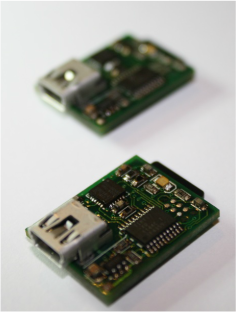
Project Goal
Design a small, compact board that fits in the thumb hole of a bowling ball and acquires data during motion. A proprietary algorithm converts the motion data into meaningful information that a bowler can use for development purposes (axis tilt, rotation, direction and speed). Board contains an embedded microcontroller for communication with a 6-axis accelerometer/gyroscope and data logging via a microSD card. A Li-Ion battery is used for power and can be charged via a mini USB connector.
Electronics
Software
Challenges
Making the device as low power as possible, converting motion data into a bowling profile, and optimizing delays/timing for high sampling rates.
Design a small, compact board that fits in the thumb hole of a bowling ball and acquires data during motion. A proprietary algorithm converts the motion data into meaningful information that a bowler can use for development purposes (axis tilt, rotation, direction and speed). Board contains an embedded microcontroller for communication with a 6-axis accelerometer/gyroscope and data logging via a microSD card. A Li-Ion battery is used for power and can be charged via a mini USB connector.
Electronics
- Embedded microcontroller (AVR)
- 6-axis, 16-bit Accelerometer and Gyroscope
- microSD card for data logging
- Li-Ion charger
Software
- AVR programmed in C using Atmel Studio
- SPI interfaces with the Accelerometer/Gyroscope and microSD card
- Misc GPIO
Challenges
Making the device as low power as possible, converting motion data into a bowling profile, and optimizing delays/timing for high sampling rates.
Accelerometer "Tilt Switch"

Project Goal
Design a small, compact board (less than 1" diameter) that acts as an electronic level and detects a tilt of +/- 2 degrees, switching an LED on/off appropriately. Board contains a button for calibration and zeroing. Design is battery powered and contains a boost converter for higher voltage conversion. It contains a microcontroller for reading the accelerometer, button input, LED control, and providing a simple algorithm that converts the data into degrees. Application is for high quantity.
Electronics
Software
Challenges
Configuring the microcontroller to give a robust, stable, and quick response to motion/orientation, and minimizing the overall bill of materials.
Design a small, compact board (less than 1" diameter) that acts as an electronic level and detects a tilt of +/- 2 degrees, switching an LED on/off appropriately. Board contains a button for calibration and zeroing. Design is battery powered and contains a boost converter for higher voltage conversion. It contains a microcontroller for reading the accelerometer, button input, LED control, and providing a simple algorithm that converts the data into degrees. Application is for high quantity.
Electronics
- Embedded microcontroller (ATTiny)
- 3-axis, 12-bit Accelerometer
- Step-up DC/DC Converter and CR2032 battery
- MOSFET for LED and Zero/Cal button
Software
- ATTiny programmed in C using Atmel Studio
- I2C interface with the accelerometer
Challenges
Configuring the microcontroller to give a robust, stable, and quick response to motion/orientation, and minimizing the overall bill of materials.
Accele'wah'meter
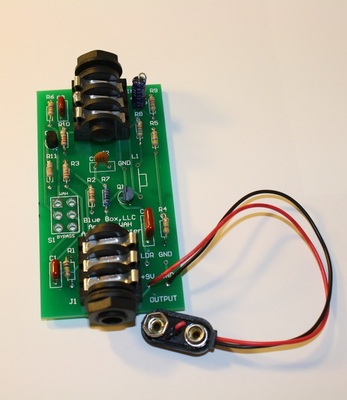
Project Goal
Design a proof of concept wireless system that produces a "wah" guitar effect by manipulating a 3-axis accelerometer. The base station contains a wireless receiver, analog wah components, embedded microcontroller, and digital potentiometer for WAH/uC interface. The clip-on module consists of a wireless transmitter, embedded microcontroller, and accelerometer. The base station plugs into the guitar amplifier while the transmitter clips on to the neck of any standard guitar. The motion of the guitar neck during play translates into a dynamic sweep of the wah effect, and can be controlled in 3 directions. Deluxe versions of the product contain different effects such as vibrato and tremolo and user controlled accelerometer sensitivity. Both modules are powered by 9 volt batteries.
Electronics
Software
Challenges
Maximizing transmission power while keeping system noise to a minimum and inventing a unique, vintage style wah circuit.
Design a proof of concept wireless system that produces a "wah" guitar effect by manipulating a 3-axis accelerometer. The base station contains a wireless receiver, analog wah components, embedded microcontroller, and digital potentiometer for WAH/uC interface. The clip-on module consists of a wireless transmitter, embedded microcontroller, and accelerometer. The base station plugs into the guitar amplifier while the transmitter clips on to the neck of any standard guitar. The motion of the guitar neck during play translates into a dynamic sweep of the wah effect, and can be controlled in 3 directions. Deluxe versions of the product contain different effects such as vibrato and tremolo and user controlled accelerometer sensitivity. Both modules are powered by 9 volt batteries.
Electronics
- 9V batteries
- 315 MHz wireless transmitter and receiver
- Analog wah circuit
- Embedded Texas Instruments microcontrollers
- 3-axis analog accelerometer
- Digital Potentiometer for microcontroller/wah interface
Software
- TI microcontrollers programmed in C using IAR Workbench
- Wireless software filtering
- Algorithms to interpret and output wah range
Challenges
Maximizing transmission power while keeping system noise to a minimum and inventing a unique, vintage style wah circuit.
